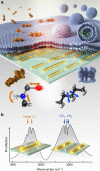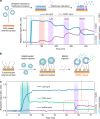Resolving molecule-specific information in dynamic lipid membrane processes with multi-resonant infrared metasurfaces
- PMID: 29867181
- PMCID: PMC5986821
- DOI: 10.1038/s41467-018-04594-x
Resolving molecule-specific information in dynamic lipid membrane processes with multi-resonant infrared metasurfaces
Abstract
A multitude of biological processes are enabled by complex interactions between lipid membranes and proteins. To understand such dynamic processes, it is crucial to differentiate the constituent biomolecular species and track their individual time evolution without invasive labels. Here, we present a label-free mid-infrared biosensor capable of distinguishing multiple analytes in heterogeneous biological samples with high sensitivity. Our technology leverages a multi-resonant metasurface to simultaneously enhance the different vibrational fingerprints of multiple biomolecules. By providing up to 1000-fold near-field intensity enhancement over both amide and methylene bands, our sensor resolves the interactions of lipid membranes with different polypeptides in real time. Significantly, we demonstrate that our label-free chemically specific sensor can analyze peptide-induced neurotransmitter cargo release from synaptic vesicle mimics. Our sensor opens up exciting possibilities for gaining new insights into biological processes such as signaling or transport in basic research as well as provides a valuable toolkit for bioanalytical and pharmaceutical applications.
Conflict of interest statement
The authors declare no competing interests.
Figures




References
-
- Stuart, B. H. Infrared Spectroscopy: Fundamentals and Applications (John Wiley & Sons, New York, 2005).
Publication types
MeSH terms
Substances
LinkOut - more resources
Full Text Sources
Other Literature Sources

